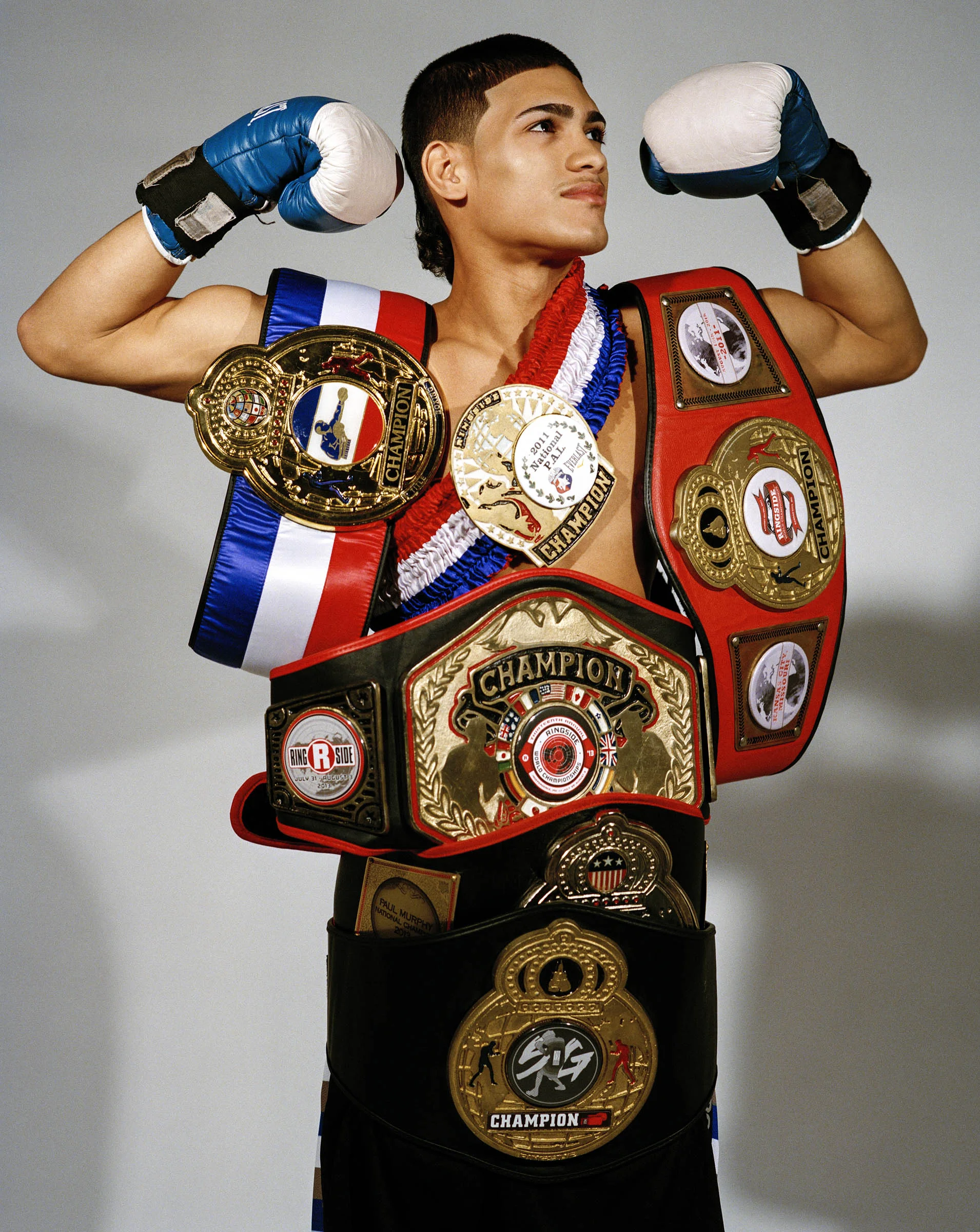Bruce Weber
Photographer and filmmaker Bruce Weber first rose to international prominence in the early 1980s on the success of images that are stylistically classical and emotionally and erotically charged. Since 2006 Weber has traveled extensively to Detroit with his camera. A result of his sojourns is Detroit: Bruce Weber, a selection of images of Detroit exhibited at the Detroit Institute of Arts in a partnership with Condé Nast Publications.
This cultural exchange of sorts between Weber and Detroit rebuts the image of Detroit as wasteland or inchoate archeological dig by showcasing the city as an inhabited place and capturing the vibrancy and dynamism of its denizens and cultural scenes. Included are portraits of activist Grace Lee Boggs, musician Patti Smith, the Detroit chapter of the Tuskegee Airmen and everyday Detroiters who embody the essence of the city. Historic Detroit locations, such as the Kronk Gym, Belle Isle Park and the Raven nightclub, are also featured.
Wayne: How did the exhibition at the Detroit Institute of Arts (DIA) come about?
Bruce: While I was on the two different assignments here in Detroit – first for W magazine, then for Shinola – I developed a real admiration for the people I encountered here. So many of the photographers I admire - Robert Frank, Cartier-Bresson, Eve Arnold - have come to Detroit and done great work here. The city has an openness about it that inspires any person who holds a camera or a paintbrush to do their own thing. Detroit gives everyone a chance, myself included.
I believe exhibitions shouldn’t be about business or fame - they should develop in a very organic way. This show at the DIA was a good example of what I mean. My wife Nan and I were having lunch with Anna Wintour [editor-in-chief of American Vogue] in New York City. I had a terrible cold. At some point, between my incessant sneezing and coughing, I said to Anna, “You should do something in Detroit - it has a style all its own that Vogue should record.” I told her about some of the people I had met and experiences I had here in the city. Anna said, “I can’t believe you’re saying this to me - just an hour ago, some people at Condé Nast said, ‘Let’s do a project in Detroit.’ I suggested an exhibition. What do you think?” I don’t usually decide something like this on the spot, but after I had some tea with honey and lemon, I said, “I want to do this - it sounds really exciting. I just hope I don’t let the people of Detroit down.” Anna can be very persuasive!
The DIA has been a beacon for so many Detroit creatives. What do you hope the exhibition will mean to the people of Detroit or what impressions about the city do you hope visitors to the exhibition will come away with?
I was photographing in Stockholm, Sweden for Vanity Fair a couple of years ago when I happened to meet an elderly woman and her husband walking down a boulevard along the water. She was wearing a mink coat and a micro mini dress and boots. Her husband was very dapper in a cap and tie and polished shoes. I just had to take their picture - they looked like two teenagers in love. So I ran up to them and dropped to my knees with my Rolleiflex and asked quickly, “Do you mind if I take your portrait? You look so wonderful together.” They said, “Of course, thank you.” That photograph became one of my favorite images from the whole sitting, because it happened in an unexpected and natural way that reflected my experience of the place.
I encountered a similar openness a lot when I was in Detroit. I’m hoping that after seeing this exhibition, the people of this city will continue to trust photographers as they trusted me. It’s increasingly difficult for photographers to go to new places and feel welcome just walking the streets and taking pictures. When I was first living in New York and studying with Lisette Model, I could wander down 42nd Street with all of its tattoo parlors and hustlers and prostitutes and policemen and gangs and mayhem and no one would look at me twice if I was taking lots of pictures. Now it’s a different story.
Detroit contains liberating creative zones, some hidden and private like social or music clubs like The Raven Nightclub; other creative zones are the street, public spaces like Belle Isle, or created via public art productions. In addition to those are there any others that have given you a strong connection to the city over the years?
I find art everywhere in my daily life, sometimes in the oddest places - a photo in the newspaper, on a marquee of an old movie theater, or in the window of a new gallery trying to make its own way. The first time I came out here, I went one afternoon to visit the Cranbrook Academy of Art, and discovered why students from all over the country and the world love to go there: the surroundings make you want to make something out of nothing. Coming back into the city, that feeling continued. I guess what I’m trying to say is Detroit as a whole feels like a natural art school to me - it makes you think, ‘Wow, there’s shape and form in almost anything.’
You have spent much of your career photographing musicians in their milieu. Detroit is well- known for its innovative music scene. I remember Motown growing up. Diana Ross went to Cass Tech, my high school. There was a class picture we used to marvel at. Anita Baker and Aretha Franklin are legendary Detroiters. In the ‘80s the new wave scene that centered on such clubs like Liedernacht in the Leland Hotel had such a creative effect, nurturing many of us to go into the arts. Then House music changed our lives almost overnight. Have you come across in Detroit today vestiges of that legacy or vibrancy?
When I first got to Detroit, I was in the car and turned on the local radio station, like I always do to get the pulse of where I am right away. And what should be playing but Marvin Gaye’s “Ain’t Nothing Like the Real Thing.” I can only say that I was obsessed with Marvin Gaye growing up - I still have that feeling for his music in my soul - so hearing that song made me feel at home right away. But I have to say, the song that touched me most when I was working on this exhibition was the Gil Scott- Heron tune, “We Almost Lost Detroit.”
Recently I was in Los Angeles and I had the good fortune to meet Berry Gordy. You can’t get any more Detroit than that. I told him how much I loved the Motown Museum here. He had a big laugh and smiled with pride. The thing that interested me at the museum was the way they incorporated sound into the installations. The recording rooms at Motown were so small they sometimes doubled as the kitchen. I love discovering that naïveté and simplicity at the beginning of something that became so influential.
Casting is an important element in your work and fosters a trusting relationship with your subjects and collaborators. Did Detroiters offer any different experiences or effect the way in which the casting process came about or evolved? Did you choose the locations and people to photograph by chance, on suggestion or by happenstance? What was the collaboration like?
For both of my projects here, I worked with Jennifer Venditti, who does lots of casting for films. She had been working here in Detroit on a project and found many of the people who you see in the exhibition. But then they’d introduce me to their friends, or I’d walk out onto the street and meet the most amazing person, and couldn’t imagine leaving without taking their portraits too.
Were there any unique personalities you discovered or any who inspired you to create a larger body of work?
When Jennifer sent back her first round of casting Polaroids, they included an amazing photo of a young guy wearing a suit—he had long hair pulled back in a ponytail and an incredible face. Dennis Freedman (who was the creative director of W Magazine in 2006) and I asked Jennifer, “Tell us more about this guy, he’s got such a great look.” She said, “Oh, no, that’s a young woman named Aungelique - I met her at her prom with her date. She’s an amazing poet.” We decided immediately that she would be Kate’s date for the W story. Aungelique was incredible in the pictures, and she wrote an ode to Kate called “Miss Perfection” that Dennis printed in W and that I included in the exhibition catalog for the DIA. In 2007, we published a small volume of Aungelique’s poetry titled Live Here, Rent Free through our imprint Little Bear Press, and I included many of my portraits of her together with images taken around the city.
One could say that the exhibition is a kind visual travel guide as well as a celebration of the city’s resiliency. Any favorite places or discoveries that stand out? Are there places not on view in the exhibition you’d recommend?
For anyone first coming to the city, I would suggest they get in the car with someone who knows the place and drive around to the various neighborhoods. I think it’s funny that when people go to a new city, they only think of the downtown where lots of people are. The spirit of Detroit for me is on the street - everything from a beautiful shoe shine parlor to a quiet block where kids are playing basketball.
Many artists and photographers have chosen Detroit as a subject often presenting it in a state of permanent decay or transition from decay to rebirth and Renaissance. The Michigan Central Station is a destination. For the exhibition and in your exploration of Detroit did you consciously work against this trend?
To be honest, I wasn’t really thinking about this when I was working here. I just wanted to photograph whatever interested me, whatever was right for expressing the way I felt about the city. When I first got here, I did photograph places like the Michigan Central Station. But then I’d come out of the building and someone would ask me what I was doing, and
I’d take a walk with them, and end up doing a portrait of them. It just happens - you can never storyboard an experience. But I tried to be open to all kinds of circumstances, and I’m constantly trying to learn how best to express what I really feel about someplace or someone. A camera is like a good friend to whom you can tell your secrets.
As a fashion photographer how would you describe Detroit’s style?
If I had to describe Detroit’s style, I would resort to what most magazines do rely on buzzwords: I’d say Detroit style is unique, sharp, sexy, spic and span, over-the-top elegant, childlike and wild.
Bruce Weber photo by Michael John Murphy














